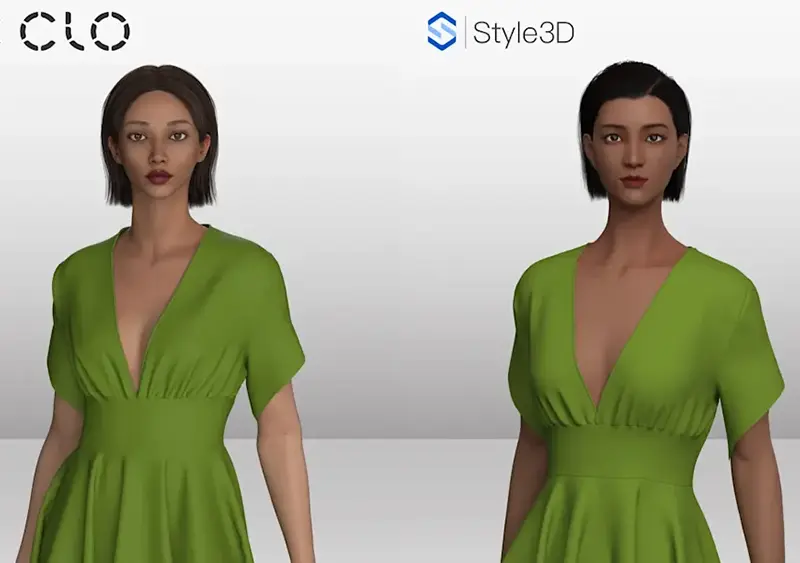CLO3D vs Style3D: Which 3D Fashion Design Software is Right for You?
See the right 3D fashion tool in action

7 MIN READ
August 14, 2025

Written By
Rahimudeen M
If you’re entering the world of 3D fashion design, two names will show up again and again: CLO3D and Style3D. They both promise speed, realism, and fewer physical samples. But choosing between them isn’t just a technical decision. It’s about which one matches your design flow, your goals, and your creative process.
Whether you’re building a sustainable brand, studying fashion tech, or upgrading from sketchbooks to screens, this comparison will help you make the right call. Let’s take a closer look at how CLO3D and Style3D really stack up.
What Are CLO3D and Style3D?
Stepping into the world of digital fashion, these two platforms might feel like rivals in the same race. But once you look closer, you'll see they’re built for different kinds of designers, workflows, and goals. Here's a quick breakdown to help you understand what each one brings to the table.
CLO3D Overview
CLO3D is one of the most recognized names in 3D garment visualization. It’s widely used in the fashion industry by brands, pattern makers, and technical designers who need precise simulations that match real-world production.
Its biggest strength lies in its accuracy. From advanced fabric physics to detailed stitching and seam control, CLO3D helps you create garments that are ready for manufacturing. It also integrates smoothly with tools like Adobe Illustrator and various CAD platforms, making it a strong choice for professionals who need to move between creative and technical stages without losing quality. You can learn more in our CLO3D beginner’s guide for fashion designers.
Style3D Overview
Style3D is a newer player but one that’s gaining fast attention, especially among design teams and brands focused on speed and collaboration. It was developed by Linctex, the company behind Browzwear, and is positioned as a platform for the next generation of digital fashion work.
What makes Style3D stand out is its focus on being lightweight, fast, and easy to collaborate with. The interface is modern, the simulations are impressively smooth, and it allows users to share designs quickly across teams without heavy software setups. For designers who value agility and want to build collections digitally with minimal lag, Style3D offers a refreshing and efficient approach.
CLO3D vs Style3D: Feature-by-Feature Comparison
Trying to decide between CLO3D and Style3D?
Here's a detailed side-by-side comparison to help you weigh the differences based on what really matters during design, collaboration, and production.
|
Feature |
CLO3D |
Style3D |
|
Pattern Making Tools |
Advanced and precise, suitable for professional production workflows. |
Intuitive and easy to use, great for visualizing ideas quickly. |
|
Fabric Simulation |
One of the most realistic engines available, with high garment fidelity. |
Optimized for speed with good realism, especially in fast design cycles. |
|
Animation & Avatars |
Offers strong control over avatar poses, animation, and runway playback. |
Currently limited, but steadily improving with each update. |
|
Learning Curve |
Can be steep for beginners, especially in technical patterning. |
Easier to pick up, especially for creatives without a technical background. |
|
Price & Licensing |
$50/month or $450/year for individuals, student plan at $25/month |
$35/month or $248/year for individuals, with AI tools starting at $8.90. |
|
System Requirements |
Demands high GPU/CPU for smooth performance and rendering. |
Lightweight software works well even on mid-range devices. |
|
Collaboration Tools |
Limited built-in sharing; external tools often needed. |
Built with real-time sharing and review tools for teams and brands. |
|
Export/Import Formats |
Supports all major 3D formats, perfect for integrating with pipelines. |
Supports fewer formats currently, but is expanding steadily. |
Here’s the next section written in a natural blog tone, with varied sentence flow and real value for the reader. It expands on the key differences with examples and clear contrast, while keeping the style friendly and informative.
Key Differences Between CLO3D and Style3D
Both platforms offer powerful 3D fashion design capabilities, they serve slightly different types of users.
Understanding their core differences will help you pick the one that matches your needs—not just in terms of features, but also mindset and workflow.
CLO3D is built for precision.
CLO3D offers the detail and control you need. Its patterns, seam lines, fabric physics, and export capabilities make it ideal for professionals who need to hand off files to manufacturers or tech teams. It’s deeply trusted in the industry, especially among larger brands and production houses that value accuracy above all. Learn more about its industry impact in how CLO3D is transforming fashion design in 2025.
Style3D leans into collaboration and speed.
This tool is ideal for designers who work in fast-moving environments like fashion startups, eCommerce brands, or design teams that need to review and iterate quickly. The interface is more modern, and its built-in sharing features make remote approvals and teamwork feel smoother. It’s also great for creating virtual showrooms or digital try-ons for online customers.
CLO3D feels like the industry standard.
You’ll find it in design schools, global fashion studios, and technical departments across major brands. But Style3D is quickly catching up, especially with a younger generation of designers who prioritize agility, cloud sharing, and cross-platform previews.
So, if your focus is manufacturing-grade accuracy, CLO3D may feel like the right fit. If you’re building fast, sharing ideas often, or working closer to the consumer experience, Style3D might give you more freedom.
Pros and Cons of Each Platform
No software is perfect for everyone. What feels like a superpower for one designer might be a drawback for another. Let’s break down the strengths and trade-offs of each platform so you can match the right tool to your workflow.
CLO3D: Pros & Cons
|
Pros |
Cons |
|
Highly realistic fabric simulation, ideal for production workflows |
Requires a powerful system with high GPU/CPU to run smoothly |
|
Industry-level pattern accuracy and garment construction tools |
Steeper learning curve for beginners without fashion tech background |
|
Widely used in global fashion houses, schools, and production studios |
Collaboration tools are limited and often require third-party platforms |
|
Seamless integration with Adobe Illustrator, CAD, and PLM systems |
Not ideal for rapid, visual-only eCommerce previews |
|
Transparent pricing: $50/month or $450/year for individuals ,Student pricing available at $25/month |
Requires more setup time and technical familiarity |
Style3D: Pros & Cons
|
Pros |
Cons |
|
User-friendly interface, fast to learn even for non-technical users |
Not as accurate for technical garment development |
|
Built-in collaboration and sharing tools for teams and remote workflows |
Avatar controls and animations are still limited in scope |
|
Ideal for digital collections, virtual try-ons, and marketing visuals |
Fewer export/import format options compared to CLO3D |
|
Lightweight performance, works on mid-range laptops |
Some advanced features may feel limited to experienced designers |
|
Flexible pricing: $35/month or $248/year for individuals ,Additional AI design tools start at just $8.90/month |
Studio plans go higher, up to $1,499/year depending on use case |
Which One Should You Choose?
The right platform depends on what kind of work you do, how fast you need to move, and what your end goal looks like. Here’s how to decide based on who you are and where you’re headed.
For Freelance Designers
If you're an independent designer juggling multiple projects or just starting to explore digital fashion, Style3D might be the better fit. It's lightweight, quick to learn, and doesn’t demand a high-end system to run. The freemium model also gives you room to experiment without a big upfront investment. Plus, the easy sharing tools make it simple to get feedback from clients or collaborators, even if they’re not in the fashion world.
For Apparel Manufacturers
CLO3D is designed for precision, and that’s what manufacturers need. From true-to-life pattern editing to seam placement, grading, and technical flat exports, CLO3D delivers accuracy at every step. If your designs are heading straight into production or need to sync with a factory workflow, this platform is more aligned with industry standards. The learning curve might be higher, but the results are production-ready.You can also explore the best free alternatives to CLO3D for digital fashion designers.
For Fashion Startups & eCommerce Brands
Need to showcase your collection fast? Want to launch a new product line digitally before making a single sample? Style3D shines here. Its fast rendering, clean interface, and real-time sharing are ideal for fast-paced environments. You can build lookbooks, create digital try-ons, and share previews without the heavy overhead. For brands operating in the digital-first space, it’s a powerful visual tool that speeds up decision-making.
Closing thoughts
Both CLO3D and Style3D are powerful in their own ways. Your choice should come down to how you work, what you’re designing for, and how much control or speed you need in your process.
Here’s a quick recap to help you decide:
- Use CLO3D if you need industry-grade garment precision, pattern control, and manufacturing-ready outputs
- Choose Style3D if you prioritize fast visuals, easy collaboration, and engaging digital presentations
- Pro Tip: If you’re still unsure, try both for a few days. The right fit will depend on how each tool feels in your real workflow
Looking to bring your designs to life in 3D?
ZealousXR offers professional 3D fashion visualization and garment modeling services tailored to your needs.
About the writer :
Rahimudeen M is the Senior Operations Manager at Zealous Services, with over 17 years of experience in project ... management and client success. He ensures smooth operations across 3D visualization, animation, and modeling projects. A natural leader, Rahimudeen is passionate about building high-performing teams and delivering top-tier results for clients across global markets.
Read MoreFrequently Asked Questions (FAQ)
Is CLO3D or Style3D better for beginners?
Style3D is more beginner-friendly due to its clean interface and simplified tools. If you’re new to 3D fashion design, you’ll likely find it easier to learn and quicker to start experimenting with real designs.
Can I use these platforms without fashion design experience?
Yes, but with a learning curve. CLO3D assumes some understanding of garment construction and pattern-making. Style3D is more forgiving for users from creative or marketing backgrounds who want to visualize clothing without deep technical know-how.
Which software is better for digital fashion marketing or eCommerce previews?
Style3D is a great choice for digital presentations. It’s fast, lightweight, and designed for easy sharing, making it perfect for creating virtual try-ons, lookbooks, or showcasing collections online.
Can I use CLO3D or Style3D for real garment production?
CLO3D is specifically built for that. It provides detailed pattern tools, fabric properties, and accurate outputs that manufacturers can work with. Style3D is catching up, but it’s currently more suited to design and presentation than full production specs.
Do these tools work on all computers?
Not quite. CLO3D requires a more powerful setup with strong graphics support, while Style3D is more lightweight and can run smoothly on standard laptops. Always check the system requirements before installing.